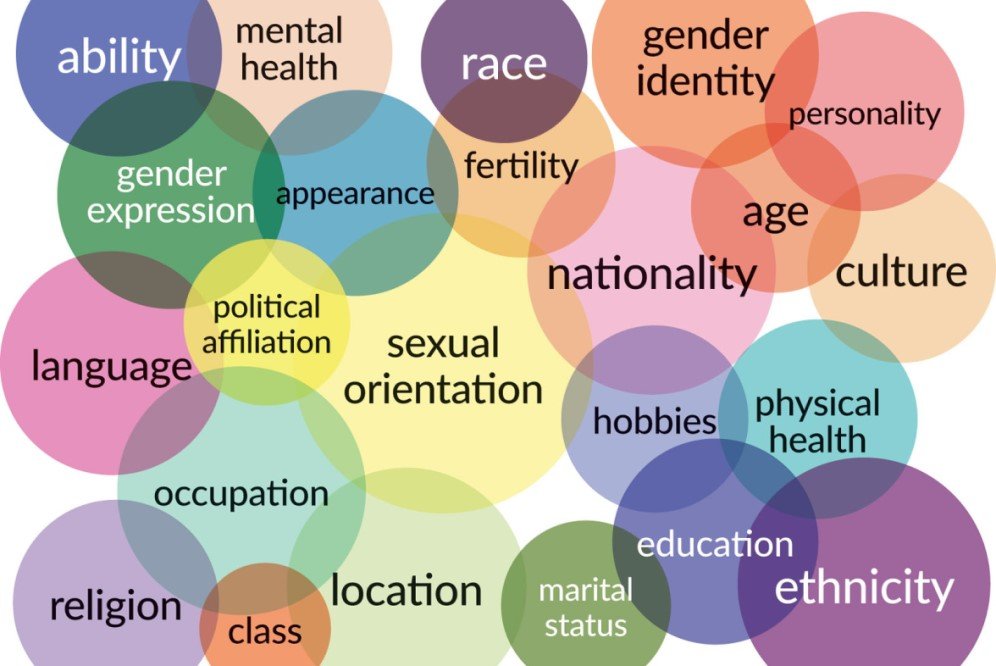The Connection Between Health, Wellness, and Intersectionality
Image source: https://icma.org/articles/pm-magazine/intersectionality-lgbtqia-community
The Roots of Intersectionality
Intersectionality is a term and theory coined by civil rights activist and scholar Kimberlé Crenshaw and it is defined as an "analytical framework for understanding how aspects of a person's social and political identities combine to create different modes of discrimination and privilege. Intersectionality identifies multiple factors of advantage and disadvantage. These intersecting and overlapping social identities may be both empowering and oppressing." (1)
This framework shows how singular yet often overlapping identities of individuals can result in varying levels of privilege or oppression - as the intersections of variables such as race, gender, class, sexuality, ability etc. create a unique and complex web of experiences, perception and social structures. Where some individuals may benefit from multiple sources of privilege, others can face compounded forms of discrimination and systemic marginalization due to the various dimensions of their identity. Additionally, individuals can (and often do) simultaneously hold identities of both power and marginalization, further expanding the dynamic nature of intersectionality and the need for this framework in our understanding of ourselves and each other.
Overlooked: Intersectionality in Health and Wellness Discourse
The social factors of health and wellness are often overlooked in many communities and fields of research, with many conversations over-emphasizing individual actions instead of acknowledging the interconnected fabric of various social networks. Intersectionality plays an especially important role in understanding health and wellness because it recognizes that individuals' well-being is shaped by an interplay of various social identities and systems of power. Health disparities and inequities are not solely determined by a single factor, such as gender or race, but are influenced by the intersections of multiple identities and their associated privileges or oppressions. For example, marginalized communities often face overlapping discrimination and may encounter limited access to education and healthcare, resulting in higher rates of chronic illnesses and poorer mental health outcomes. Numerous communities of color contend with industrial power plants, leading to exposure to pollutants and negative health impacts (2), a form of environmental racism (3). Embracing an intersectional perspective enables healthcare professionals and policymakers to better address the distinct needs and challenges of individuals with multiple identities, fostering more inclusive and equitable healthcare systems and promoting holistic well-being for all.
What’s it all for?
By incorporating an intersectional lens in nutrition, wellness, and healthcare initiatives, we can gain a deeper understanding of the multi-dimensional factors that shape individuals' access to food, dietary choices, cultural influences, and overall well-being. Intersectionality helps uncover and address health disparities, promotes inclusive and equitable approaches to wellness, and acknowledges the diverse experiences of individuals across intersecting sectors of identity. By working towards more inclusive and culturally sensitive practices, we can create environments that support the holistic wellness of all individuals, and create a more empowered, healthy and genuinely interconnected world.
Where can you start?
1) Educate yourself further: Learn more about environmental justice, intersectional theory, and the communities around you that might be negatively impacted by discriminatory policies and practices.
2) Engage in the conversation: Initiate dialogues with friends, family, and community members about the intersectionality of health, fostering understanding and collectively addressing the systemic issues affecting well-being.
3) Seek out diverse voices: Amplify and uplift underrepresented perspectives in health and wellness by seeking out and promoting content, stories, and experiences from diverse voices within your community and beyond.
4) Keep an open mind: Embrace a mindset of continuous learning and empathy, acknowledging the complexities of individual experiences shaped by various social identities, and be receptive to evolving perspectives on health and wellness.
5) Learn about body neutrality: Explore and educate yourself on the concept of body neutrality, fostering a positive relationship with one's body that transcends societal norms, promotes self-acceptance, and contributes to a more inclusive understanding of well-being.
Be well,
Joelle
Resources and citations:
1) https://en.wikipedia.org/wiki/Intersectionality
https://www.intersectionaljustice.org/what-is-intersectionality
2) https://www.epa.gov/power-sector/power-plants-and-neighboring-communities


